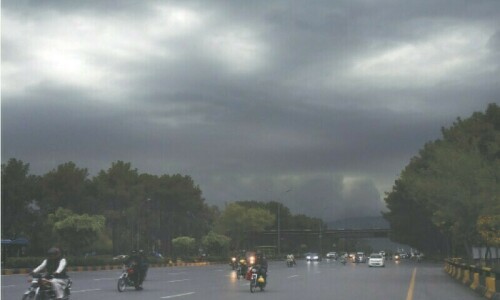The monsoon rains have returned while Pakistan still reels a year after super floods caused by the climate-induced rains that inundated at least one-third area of the country, displaced eight million people, killed more than 1,700 and washed away $30 billion worth of infrastructure, crops and livestock.
A large number of flood-hit and displaced communities still live without shelter, food, medicines, and jobs as the government, strapped for cash to help the affected millions, scrambled for financial resources to rehabilitate them and repair the damaged infrastructure.
More than 50 people have already lost their lives in fresh weather-related events in the last few weeks. The expected record-breaking monsoon this summer is feared to disrupt further the painfully slow recovery from last year’s damages.
The World Bank estimates that Pakistan requires $16.3bn for reconstruction and rehabilitation in the aftermath of last year’s floods. But the nation has been able to rake up just a few hundred million dollars despite pledges of nearly $10bn by multilateral and bilateral partners in January at the Climate Resilient Pakistan conference in Geneva.
Climate-related disasters (excluding last year’s floods) have affected over 75m Pakistanis in the last 30 years, with economic losses of $29bn, or roughly $1bn a year
Abid Suleri, a development practitioner, says Islamabad has so far received nearly $300 million as the Geneva pledges were tied with the resumption of the International Monetary Fund’s lending.“Importantly, the multilateral basically repackaged their earlier lending commitments in these pledges.”
Besides, Pakistan was also promised nearly $250m from the ‘Global Shield’ fund, a World Bank initiative to finance countries suffering from climate disasters, at the COP27 climate summit last November. It remains unclear if Islamabad has received any funds under this initiative.
At COP27, a ‘Loss & Damages Fund’ — essentially a climate compensation scheme based on the historical responsibility of global warming — was also established after Pakistan and China galvanised support for it.
The modalities of the fund are yet to be agreed upon at COP28 later this year. “It is unclear how much of that will happen at COP28 and if Pakistan and other climate-affected nations receive any money in the next few years,” Zain Moulvi, director of research at the Alternative Law Collective, argues.
For 20 years, Pakistan has ranked among the top 10 most vulnerable countries on the Climate Risk Index as global warming threatens the socioeconomic stability of the country on the frontline of the climate emergency. While the country is responsible for less than one per cent of global greenhouse gas (GHG) emissions, UN Secretary-General António Guterres says it is paying a supersized price for man-made climate change.
A World Bank report — From Swimming in Sand to High and Sustainable Growth — released in October says weather- and climate-related disasters (excluding last year’s floods) have affected over 75m Pakistanis in the last 30 years, with economic losses of $29bn, or roughly $1bn a year.
“These estimates don’t even include damage to biodiversity, ecosystem, mangroves, and many other losses due to changes in weather patterns,” Mr Moulvi emphasises.
The impacts of climate change have manifested themselves around the world, increasing in intensity and ferocity with every coming year, Haneea Issad, an energy finance analyst at the Institute for Energy Economics and Financial Analysis, says.
“In Pakistan, the devastation from these incidents is more pronounced because we’re ill-equipped to deal with the scale of these disasters. And these events will only become more frequent and extreme in the decades to come.”
The climate crisis is hitting the nations hardest that have historically had the least to do with its causes. “It has raised questions over who should pay for the damage, particularly for damages that countries like Pakistan have to suffer,” says Mr Moulvi.
Poor countries are looking for reparations from rich nations for damages caused by climate-triggered disasters, funds for mitigation- and adaptation-related policy changes, and cancellation of huge debts to free their resources for climate-resilient infrastructure.
The cumulative GHG emissions originating from developed economies have significantly outpaced developing countries. As per International Energy Agency, G7 accounted for 34.5pc of the world’s total emissions in the energy sector from 1971 to 2020.
The US alone takes up 20pc of the world’s total, nearly 56x higher than Pakistan, and is the world’s leading GHG emitter. The US per capita emissions from energy outpaced Pakistan by 17x. Yet, the world’s largest economy has not committed anything to help the disaster-hit nations.
A Lancet Planetary Health study says 92pc of the excess GHG emissions are coming from the Global North, which controls 80pc of the global wealth and has 25pc of the world’s population.
The Global Shield funding is neither sufficient nor commensurate with the responsibility developed countries must take as major GHG emitters. The developed world must deliver on its over-a-decade-old commitment to provide $100bn a year to developing nations to fight global warming, transition away from fossil fuels and adapt to climate change. That pledge was never fulfilled to ensure the developing economies’ right to development.
That is why the poorer countries at the centre of the climate emergency called for ‘rethinking global financial architecture’ and mobilising financial support for developing and low-income countries facing the challenges posed by their excessive debt, climate change and poverty.
“Concessional multilateral financing for climate mitigation and adoption is scarce and comes tied to conditions to benefit foreign firms and consultants. Projects are chosen by the lenders or donors even though they don’t understand Pakistan’s climate issues, exacerbating the problems for the host nations.
“This creates a vicious cycle of debt, leading to a situation where debt repayments use up a significant portion of their resources (as is the case with Pakistan),” Mr Moulvi contends.
China has led the global energy transition in the last 10 years and has invested $266bn in the initiative. Other major polluters, including the US, lag far behind Beijing.
China has expressed its willingness to enhance cooperation for green development. The two countries have agreed to step up cooperation under the China-Pakistan Economic Corridor initiative in such areas as ecosystem restoration and water resource management.
Last year, both sides agreed to launch a Green Corridor to focus on the agricultural environment, food security and green development as part of their collaboration toward a green future.
Many believe China’s solutions to climate change are more feasible for countries like Pakistan since China’s status as a developing nation allows it to relate to the realities of other developing economics and formulate a more suitable and effective plan for tackling climate change.
Beijing is also encouraging Chinese companies to help Pakistan’s endeavour for green, low carbon and environment-friendly development and participate in Prime Minister Shehbaz Sharif’s new 10,000-megawatt solar energy initiative that requires an investment of $6bn.
Published in Dawn, The Business and Finance Weekly, July 17th, 2023














































Dear visitor, the comments section is undergoing an overhaul and will return soon.